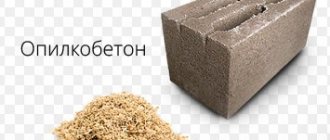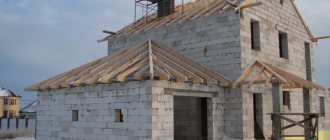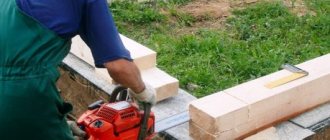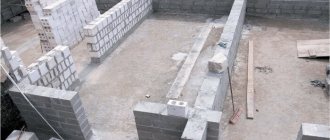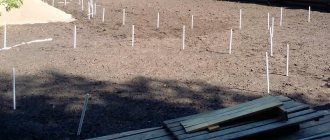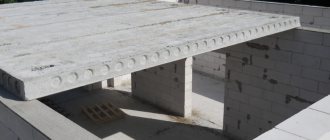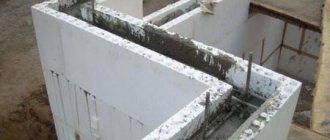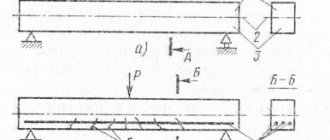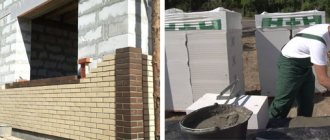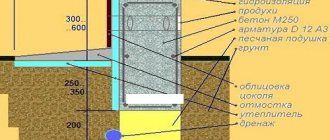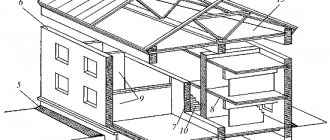Features of houses
Apartment buildings are built from 3 building materials: panels, brick or monolith. Each of these materials affects the technical characteristics of a high-rise building.
Brick apartment building
Qualified masons are hired to build high-rise brick buildings. The masonry is driven out for quite a long period.
The lifespan of the house reaches 150 years, i.e. it is designed for 2 generations.
Apartments in such buildings usually have ceiling heights of up to 3 m and have high heat and sound insulation.
Prices for apartments in brick high-rise buildings, especially modern ones, are the highest. But apartments in “Stalinka” and “Brezhnevka” apartments are much cheaper.
Panel houses
Panel buildings with standard apartment layouts appeared during the Soviet period . Interpanel seams are considered their weak point. The panels themselves can be single-layer or multi-layer.
Modern panel houses have significantly improved their performance properties, but the risk of background radiation still exists.
Panel high-rise buildings are built much faster than brick ones. Their service life is about 45 years . In old-style buildings, everything is regulated by a standard height.
But the cost of such apartments is the lowest, since construction work is carried out in a short time, and the material has a fairly low cost.
Monolithic buildings
Monolithic construction involves the connection of reinforcement and high-strength concrete. This technology has proven itself well in the construction of high-rise buildings.
However, for the conditions of the Russian climate, a monolith is not the best solution due to its high thermal conductivity . This problem can be solved by building a monolithic brick house.
This technology allows us to eliminate the disadvantages of reinforced concrete. The frame is made of a monolith, and the walls are laid out of brick or aerated concrete with insulation.
Construction of the 5-story building will be completed in 18-19 months. If all rules are followed, the service life of the structure will be about 150 years.
Monolithic construction also pays off in terms of comfort, allowing you to implement different architectural forms and layouts. The strength and wear resistance of houses is increased by the absence of seams.
As for the price, an apartment in a monolithic brick building will cost less than in a brick building, but more expensive than in a panel house.
Were you interested in the type of house when you were or are choosing an apartment in a suitable residential complex? Then you should know the difference between a panel house and a monolithic or brick one. Today there are several main series of houses: panel, brick, monolithic and monolithic-brick. They differ in technical characteristics and, accordingly, in price.When choosing an apartment, it is important to remember that in the 90s, construction standards were often violated, so it is better to avoid such high-rise buildings.
Panel house The main advantage of a panel house is its relative cheapness and construction of the building in a short period of time. Panel house technology is construction from ready-made blocks produced at house-building factories. House-building factories themselves calculate production capacity and deliver panels to the construction site themselves, so that downtime during the construction of a house can be avoided. But panel houses have a serious drawback - these are the so-called “cold paths” formed due to joining seams and protruding parts of the floor. The result is poor heat and sound insulation. Panel housing construction has exhausted itself. This is primarily due to the fact that the buyer has become more demanding, and the quality of panel houses no longer suits him. The future lies in more durable and reliable technologies. Brick house Brick houses enjoy deserved popularity not only in our country, but throughout the world. Strong and durable buildings of any architecture and complexity are erected from brick. Housing in brick houses is high quality and comfortable. Brick houses “breathe” better and are much more environmentally friendly; They are heat-intensive and have a high degree of fire protection. Brick is not susceptible to the appearance of fungi and microorganisms. Brick houses are usually classified as luxury housing. Brick construction technology requires long construction times and increased labor intensity. As a result, the cost per square meter in a brick house is, as a rule, slightly higher than in a panel and monolithic one. Brick-monolithic (monolithic) house Monolithic house construction is the most advanced construction technology, which is becoming increasingly popular. Apartments in monolithic buildings, according to experts, are the most liquid type of real estate and they are the ones that are bought up first. Completely monolithic new buildings are quite rare; most often these are brick-monolithic new buildings. The basic principle of monolithic construction is that the load-bearing skeleton of the building is made of concrete: during construction, a rigid frame is created with various types of enclosing structures. External walls are brick with a layer of heat-insulating material or panel. One of the advantages of monolithic houses is their individuality. Each house has its own design, it is original and unique. An important feature is that in most rented houses the apartments have only load-bearing walls, and the size and configuration of the premises and how many there will be is decided by the buyer. In these houses you can create an open layout and embody your ideas and vision of housing. An equally valuable advantage of brick-monolithic houses is the possibility of installing an underground garage and other necessary additions. The construction of monolithic houses is carried out by pouring concrete into finished formwork, which allows you to be proud of perfectly smooth walls, floors and ceilings. A monolithic brick house, in addition, is additionally finished with brick, which has a positive effect on both the appearance of the house and its characteristics. Monolithic brick buildings are durable, have increased thermal insulation properties and are environmentally friendly. The use of this technology avoids sedimentary cracks. Such houses wear out very slowly, so you can always sell an apartment in it at a profit. Experts say that the actual lifespan of the “monolith” is more than 100 years. However, this statement can be questioned if the developer used cheap and low-quality materials. In this case, even building a house using monolithic technology is not a guarantee of quality. A guarantee of a high quality home for you can be the reputation of the developer and the quality control system he created, which gives you confidence that only high-quality materials and technologies that have undergone special testing are used during construction.
| Next > |
Which is better: a monolithic house or a panel house?
Thousands of Russians live in panel high-rise buildings. Houses built using old technologies have a standard appearance.
But residential buildings of the P-3M, P-44T, GSM-1, KOPE series are a very worthy alternative to durable monolithic buildings and, thanks to the use of modern technologies, can seriously compete with them.
Panel high-rise buildings are characterized by:
- small apartments;
- quite functional layout;
- low price.
An apartment in a panel house is almost ready for renovation, which cannot be said about brick or monolithic houses.
Apartments in monolithic buildings have a larger area. They can be designed individually due to the lack of interior partitions. But this increases the cost of repairs.
Muscovites highlight the following advantages of apartments in a panel house:
- low cost (26%);
- high construction speed (15%);
- “Cool in summer, warm in winter” (8%).
About 29% of Muscovites surveyed do not see any advantages of living in a panel house, and 8% of people living in such high-rise buildings are satisfied with everything. Meanwhile, 14% of Muscovites expressed their outrage at the living conditions in panel houses.
Among the disadvantages they name:
- high audibility;
- complexity of redevelopment;
- unattractive appearance;
- fragility.
Which apartment to choose: in a monolithic building or a panel one? The question remains open and is resolved for each person individually. The choice depends on the capabilities and priorities of buyers.
If you choose something cheaper, then opt for an apartment in a panel high-rise building, and if you prefer quality, durability and a non-standard layout, then it is better to opt for an apartment in a monolithic building.
Panel houses
According to Muscovites, approximately 29% do not highlight any advantages, 26% are pleased with the low cost of such housing, the high speed of building a house is to the liking of 15% of the capital's residents, 8% of the capital's residents are absolutely satisfied with everything, 8% of Moscow residents believe that panel houses it is cooler in summer and warmer in winter, and only 14% of Muscovites live in panel houses and are not satisfied with the conditions.
Negative qualities of panel houses, which are called by residents of such buildings: low quality, low level of sound insulation, difficulty in redevelopment, unsightly appearance. When characterizing panel-type houses, the following phrases were most often mentioned: “I can hear everything the neighbors are doing,” “the ceiling and walls may crack,” “it’s cold in winter,” “unattractive view,” “inconvenient,” “the house is fragile.”
What is the difference between a monolithic house and a panel house?
Monolithic buildings today can safely be called houses of a new generation. But buildings of this type also have both strengths and weaknesses.
The advantages of the monolith are:
- strength of the house;
- possibility of individual redevelopment;
- high level of sound and heat insulation.
Residents of such houses identified the following disadvantages:
- high cost of housing;
- lack of partitions;
- poor quality of some buildings;
- long construction.
43% of residents are confident that monolithic houses are the strongest and most durable, have an attractive appearance, and allow any redevelopment. At the same time, 30% of Muscovites believe that apartments in such a high-rise building are too expensive.
Panel houses
According to Muscovites, approximately 29% do not highlight any advantages of panel houses, 26% are pleased with the low cost of such housing, the high speed of building a house is to the liking of 15% of the capital's residents, 8% of the capital's residents are absolutely satisfied with everything, 8% of Moscow residents believe that panel houses are cooler in summer and warmer in winter, and only 14% of Muscovites live in panel houses and are not satisfied with the conditions.
Negative qualities of panel houses, which are called by residents of such buildings: low quality, low level of sound insulation, difficulty in redevelopment, unsightly appearance. When characterizing panel-type houses, the following phrases were most often mentioned: “I can hear everything the neighbors are doing”, “the ceiling and walls can crack”, “it’s cold in winter”, “unattractive view”, “inconvenient layout”, “the house is fragile” .
Which house is better: brick or monolithic?
All monolithic houses are built according to the following principle: formwork of the required height (made of wood, plastic or metal) is raised around a metal frame, into which a concrete mass is pumped.
This process is quite lengthy and requires full adherence to technology. But the walls turn out to be absolutely seamless, which gives warmth and excellent sound insulation.
Brick houses are considered the best for living, especially if ceramic bricks were used for construction. This building material is environmentally friendly, breathable, and holds heat well.
For example, double sand-lime brick M 150, often used by developers to save money, has insufficient thermal insulation properties, so builders using this brand increase the thickness of the masonry or insulate the walls additionally.
Today, brick buildings are rarely built due to their high cost. Mostly mixed high-rise buildings are built - monolithic brick, which allows to increase the life of the house and its number of storeys.
Advantages of brick buildings:
- reliability, strength, durability;
- environmental friendliness;
- the ability to embody various architectural forms (arches, columns, etc.);
- relative resistance to fire.
Flaws:
- long construction period;
- high costs for interior work (often walls and ceilings are uneven);
- duration of shrinkage of premises;
- high cost of bricks.
Advantages of monolithic buildings:
- strength and rigidity of the structure;
- good sound insulation;
- less load on the foundation;
- saving on heating.
Disadvantages of "monoliths":
- the reinforced concrete frame hardly “breathes”;
- low natural sound insulation, additional soundproofing pads are needed;
- high costs for technical equipment.
It should also be understood that a lot depends on the quality of construction . Even good interior finishing can negate all the advantages of the material.
Brick houses
Another type of residential buildings that are deservedly popular. Brick houses, like panel houses, have many advantages. However, due to the high cost of their construction, they are being built less frequently today. And the duration of construction of a brick house is relatively long. The complete construction of such a structure will take 1.5-2 years.
However, due to the large number of advantages, brick houses are classified as premium-class housing.
Construction technology
According to its characteristics, brick is considered the most suitable for residential buildings. Related to ceramic products, brick is able to regulate moisture absorption and improve the microclimate in the room. For the construction of a residential building, ceramic bricks are considered the best. Ceramic brick is also an excellent insulator. And using it in construction allows you to get warm buildings. This means reducing heating and utility costs.
Sand-lime brick is also used in the construction of a brick house. It is less able to retain heat. Therefore, buildings made from it have to be additionally insulated. In modern construction, combined versions of monolithic products and bricks are used. This approach makes it possible to create unique facades of residential buildings.
Advantages and disadvantages of brick houses
Brick houses have more advantages than disadvantages. The disadvantages include the long construction period and the high cost of apartments in such houses. But there are much more advantages:
- the ability to create original and unusual architectural solutions;
- the highest rates of noise and heat insulation;
- buyer confidence in building materials such as brick;
- beautiful appearance of the brick building;
- significant service life of a brick building - about 150 years;
- brick is able to absorb and release moisture. This means that there will never be mold or fungi indoors;
- ideal microclimate for living. The apartments in brick houses are warm in winter, and cool in summer.
As can be seen from the list, brick, like panel houses, have many advantages in construction. However, the characteristics of each type of building material should also be taken into account.
Which house is better: brick or monolithic brick?
Monolithic brick technology for building houses is relatively young, but has already proven itself well all over the world. Apartments in such buildings have a number of advantages, the main one being the reliability of the structure.
The base of the building is a concrete frame on which brick is laid. The technology implies the mandatory use of thermal insulation materials.
All monolithic brick houses are built according to individual projects . Walls that are not load-bearing are erected inside the apartment, so if desired, the owner can design the layout of all the rooms himself. Monolithic brick houses are modern and allow the construction of underground garages and parking lots.
The great advantage of monolithic brick houses is the strength of the buildings . Brick gives the building an excellent appearance, holds heat and sound well, is environmentally friendly and harmless.
Having bought an apartment in such a building, you don’t have to worry about a decrease in its value. The service life of a monolithic brick building is more than 100 years.
Modern technologies have stepped far forward. Houses built from pure brick are very rarely built. Most often, developers prefer to work with a mixed type, combining monolith and brick. But for private housing construction this approach is inconvenient.
It is impossible to say unequivocally what is better: a brick, monolithic or panel house . In each case, a person makes his optimal choice.
If you want a budget option, look for an apartment in a panel house. And if you decide to purchase a modern apartment with a non-standard layout and underground parking, opt for houses built using mixed technologies. The choice always remains with the buyer.
Frame houses are assembled in different ways
In modern construction, there are several similar technologies for constructing houses of this type. In low-rise construction, these are classic frame houses, as well as frame-panel and frame-reed buildings, which are based on the frame manufacturing principle. However, the listed types of construction have differences in the method of assembly, design and, of course, filler. They have one thing in common: a record high construction speed.
The insulation used in the construction of a frame house is usually basalt or mineral wool, as well as polystyrene foam or polyurethane foam. Previously, reeds and sawdust were used for this, which is where the corresponding name came from. On the outside, and sometimes on the inside, the insulation is covered with cement-bonded particle boards or plywood, which are lined with facade plaster.
Here are the main differences between the two most common types.
By the way, the country’s first house built using the prefabricated frame method was recently commissioned in Aktau. The nine-story building was assembled in just six months.
Features of a monolithic brick building
A monolithic brick house is a housing structure made of brick and concrete frame.
Its advantages:
- no seams,
- possibility of external decoration thanks to the use of multi-colored bricks,
- Possibility of operation for about 100 years .
The disadvantages of a monolithic brick product are:
- low sound insulation due to the ability of concrete to transmit noise,
- insufficient thermal insulation, which is why the house needs additional insulation.
Monolithic house - types of formwork ↑
Removable ↑
In the case of using removable formwork, after the concrete solution has hardened, the frame is removed and placed on an adjacent site for re-filling with the building mixture. Naturally, we are talking about reusable formwork, which is usually used in the construction of industrial and residential multi-story buildings.
Fixed ↑
After pouring, such formwork structures are not rearranged anywhere, but remain as part of the structure. In addition, permanent formwork is used not only for pouring concrete, but also to increase the insulation of heat, water and sound. Typically, such systems are used in private construction.
In addition, the formworks of monolithic houses have differences in the frame:
- Panel frame . Formwork parts are produced for all types of buildings and connected directly on site.
- Tunnel frame . It consists of ready-made formwork parts that were manufactured for certain types of building structures.
Monolithic house - varieties ↑
Monolithic frame house ↑
This is a type of lightweight buildings that are almost no different from ordinary monolithic houses. The only difference is in the supporting elements. The bottom line is that when constructing standard monolithic houses, the main load falls on the columns, and when using monolithic frame technology, the walls are also involved in the load.
In addition, external wall panels are made from lightweight materials, making any room layout possible.
Brick-monolithic house ↑
This type of monolithic house is also produced by pouring concrete directly at the construction site. Then the outside is covered with bricks, and a sealant with waterproofing is laid between the masonry and the reinforced concrete frame - otherwise, if moisture gets in, the bricks will begin to bulge.
With this method of pouring, a formwork system must be used, otherwise the structure simply will not be seamless.
Monolithic house - results ↑
Yes, monolithic houses have their disadvantages, but for many customers the advantages outweigh them. A monolithic house is more expensive and requires extra costs in terms of effort and time, but taking into account that it will last at least a century and a half, it turns out that your grandchildren’s grandchildren will also have time to live in it before it needs repairs.
Houses around you will be demolished due to unsuitability, people will be displaced, and your descendants will look at this from the balcony and thank you.
Think about it.
Monolithic buildings
Monolithic buildings are no less in demand. The beginning of their construction is considered to be the 90s of the last century. And today such designs have not lost their relevance.
A feature of such buildings is the possibility of creating a completely non-standard facade design. The solution is poured into pre-assembled formwork.
What is better - monolith or brick? ↑
Advantages of monolithic houses over brick ones ↑
So, we understand what a monolithic house is. Why is he so good?
- Light weight of the structure due to the thinner walls.
- Problematic soil for a monolithic house is not a problem.
- Duration of operation - up to 150 years (!).
- Extreme water resistance (even a flood).
- Extreme seismic resistance (up to 8 points).
- After completion of construction, you can immediately begin finishing work without any problems.
- The load on the foundation is equally distributed.
- The internal area will be 10% larger due to the fact that the walls can be made not so thick, but the strength will still be enough.
- Freedom to erect a building of any number of floors, layout, architectural style.
- Free redevelopment in the future.
